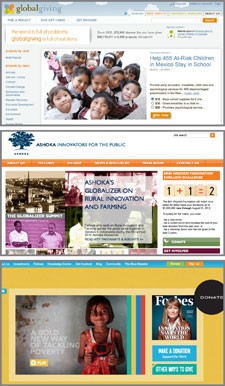
A lot of good is being done around the world and lots of people want to support those good works. But it’s hard to expose grassroots organizations to potential donors around the world and it’s hard for donors to learn about projects that excite their interest.
Worse yet, sometimes when you find out about an organization, it’s not doing what the lovely website and publicity claim it is doing. Think Central Asia Institute, the “Three Cups of Tea” organization. It was said to be providing education, especially to girls, in Pakistan and Afghanistan but … it turns out, not really.
Crowdfunding Platforms Connect Buyers and Sellers
Enter GlobalGiving, an online marketplace, that connects those who do good work with those who want to support them. Donors can search for projects to support by location or type of work done, such disaster recovery, education or health.
This collective pooling of infrastructure and visibility for fundraising purposes is called “crowdfunding.”
For Donors, Crowdfunding Provides Confidence and Due Diligence
Even if you’re giving as little as $10, you want some assurance that the nonprofit receiving your donations is really making a difference. Just like the New York Stock Exchange vets companies before their initial public offering, GlobalGiving vets nonprofits before listing projects on the site.
GlobalGiving checks the reputation of project leaders and their organizations with others who work in the space, such as Ashoka, IDEX ,and the Acumen Fund. Compliance with international guidelines for philanthropy and anti-terror guidelines are verified. GlobalGiving makes sure the organization has a good track record and that their work has an impact.
GlobalGiving recruits volunteers to conduct site visits and audits a significant percentage of sites over time. Visits are prioritized to areas that have the heaviest volume of donations. This year, it is visiting Japan to follow up on disaster-relief funds. Staff members are also sent to key places to check in on nonprofits and the impact they are having.
“We designed our field program to ensure that our intake and due diligence processes are working as designed,” said John Hecklinger, GlobalGiving’s Chief Program Officer. “We calibrate our field presence to match donation flow and, while our field work is partially about monitoring activities of grantees, it’s just as much about helping them make better use of GlobalGiving’s suite of services.”
Project leaders periodically update donors on the progress of the projects, just like a public company updates shareholders with quarterly and annual reports.
Corporations including Nike, Dell, Lilly, and Discovery are so impressed with GlobalGiving’s process that they use GlobalGiving for sourcing, vetting, and facilitating contributions to nonprofits; providing infrastructure for cause marketing programs; and facilitating corporate employee matching programs, among other things.
GlobalGiving also does one thing the NYSE doesn’t: It offers a money back guarantee.
For Nonprofits, Crowdfunding Provides Exposure and Support
For nonprofits, GlobalGiving offers training on successfully promoting their projects on GlobalGiving. “For NGOs accessing online tools for the first time, we’ve found that support and training can really make a big difference in their ability to raise funds and expand networks,” said Hecklinger. “Our field work is not just designed to monitor, but to support and activate our project organizations.”
Before being allowed to join GlobalGiving, nonprofits need to show they’ve got what it takes: a mission with a following. Each must raise $4,000 from at least 50 donors during a trial period, called an Open Challenge, before they can become a GlobalGiving project. For those who do measure up, support continues through training, consultations, and access to peer support.
Intermediaries such as GlobalGiving bridge the information gap between nonprofits and potential donors. It’s a combination of a marketing consultant who increases the nonprofit’s visibility and the Good Housekeeping seal of approval that gives donors confidence that their donations are put to good use.
And it’s another example of the ways in which the internet and social media bring people and organizations together.
